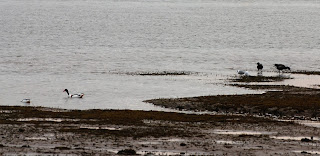First gull egg of 2016 (Dan Wynn)
o
Spring comes to the Plantation (Harry Mitchell)
Black-headed Gulls aren't the only birds nesting on the Point. We have found two duck nests this week and the first wader nest was found today. Two of our faithful Oystercatchers are back on their usual territories - we know they are the same birds returning because they have metal rings on their legs.
Mallard nest (Ajay Tegala)
'Fatima' is in her 20s and nests in or around Great Sandy Low every year.
She is now on her usual breeding territory for 2016.
Note the metal ring on her leg (Josh Barber, 2015)
This week's low tide seal count recorded 117 Grey and 14 Common hauled out on the West Sands. On Thursday, we noticed a female Common Seal with a very small pup. This is quite early and it is thought, sadly, that the pup was stillborn. The usual pupping time for Common Seals is June-July, but there are records of early stillbirths (8th of May 1991 on Far Point, for example).
'Fatima' is in her 20s and nests in or around Great Sandy Low every year.
She is now on her usual breeding territory for 2016.
Note the metal ring on her leg (Josh Barber, 2015)
This week's low tide seal count recorded 117 Grey and 14 Common hauled out on the West Sands. On Thursday, we noticed a female Common Seal with a very small pup. This is quite early and it is thought, sadly, that the pup was stillborn. The usual pupping time for Common Seals is June-July, but there are records of early stillbirths (8th of May 1991 on Far Point, for example).
Common Seal and pup (Wynona Legg)
Common Seal and pup (Dan Wynn)
It has been a very quiet week on the migration front. Literally the only bird of note was a Firecrest, by no means a common migrant on Blakeney Point, this delightful bird was found by our friend Pete Dolton.
Firecrest in the Plantation (Dan Wynn)
Last night's roost count recorded an estimated 2,000 Sandwich Terns on Far Point, a fantastic sight and sound. We expect to see the first Common, Arctic and Little Terns any day now.
Roosting Sandwich Terns (Tom Green)
We leave you with news that signs of pirates have been found on the Point...
Ajay, Blakeney Point Ranger



















